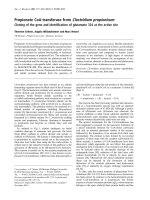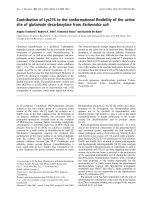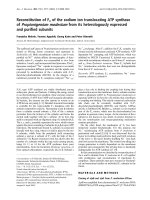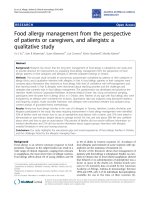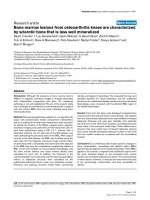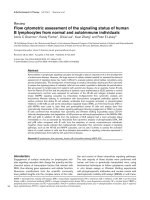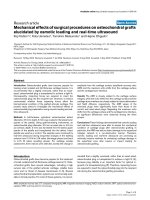Báo cáo y học: " Mechanical ventilation: lessons from the ARDSNet trial" ppsx
Bạn đang xem bản rút gọn của tài liệu. Xem và tải ngay bản đầy đủ của tài liệu tại đây (136.8 KB, 5 trang )
commentary
review
reports primary research
Commentary
Mechanical ventilation: lessons from the ARDSNet trial
Arthur S Slutsky and V Marco Ranieri*
St Michael’s Hospital, University of Toronto, Toronto, Canada, and *Ospedale Sanata Chiara,
Università di Pisa, Pisa, Italy
Abstract
The acute respiratory distress syndrome (ARDS) is an inflammatory disease of the lungs
characterized clinically by bilateral pulmonary infiltrates, decreased pulmonary compliance
and hypoxemia. Although supportive care for ARDS seems to have improved over the past
few decades, few studies have shown that any treatment can decrease mortality for this
deadly syndrome. In the 4 May 2000 issue of New England Journal of Medicine, the results
of an NIH-sponsored trial were presented; they demonstrated that the use of a ventilatory
strategy that minimizes ventilator-induced lung injury leads to a 22% decrease in mortality.
The implications of this study with respect to clinical practice, further ARDS studies and
clinical research in the critical care setting are discussed.
Keywords: acute lung injury, artificial respiration, barotrauma, biotrauma, iatrogenic, respiratory failure
Received: 17 July 2000
Revisions requested: 17 August 2000
Revisions received: 18 August 2000
Accepted: 18 August 2000
Published: 31 August 2000
Respir Res 2000, 1:73–77
The electronic version of this article can be found online at
/>© Current Science Ltd (Print ISSN 1465-9921; Online ISSN 1465-993X)
ARDS = acute respiratory distress syndrome; HFV = high-frequency ventilation; ICU = intensive care unit; MSOF = multiple system organ failure;
PBW = predicted body weight; PEEP = positive end-expiratory pressure; P
plat
= plateau pressure; VILI = ventilator-induced lung injury; V
t
= tidal
volume.
/>Introduction
ARDS is an inflammatory disease of the lungs character-
ized clinically by bilateral pulmonary infiltrates, decreased
pulmonary compliance and hypoxemia [1,2]. Despite
intense research for decades, the mortality rate in patients
with ARDS remains very high, although there is some evi-
dence that these rates might be decreasing [3]. Interest-
ingly, although the major initial physiological abnormalities
are often pulmonary in origin, patients who go on to die of
their acute illness usually die of multiple system organ
failure (MSOF) rather than a respiratory death (ie hypox-
emia). Virtually all patients with ARDS require mechanical
ventilation to provide adequate oxygenation; this therapy is
supportive, providing time for the lungs to heal.
As with any therapy, there are side effects of mechanical
ventilation; for decades our understanding of these com-
plications was largely limited to the gross air leaks
induced by the large transpulmonary pressures — so-
called barotrauma. Over the past decade we have learned
about more subtle detrimental sequelae of mechanical
ventilation, based largely on basic studies on mechanisms
of injury [4]. These studies have demonstrated that
mechanical ventilation can induce injury manifested as
increased alveolar-capillary permeability due to overdisten-
sion of the lung (volutrauma) [5], can worsen lung injury by
the stresses produced as lung units collapse and re-open
(atelectrauma) [6,7], and can lead to even more subtle
injury manifested by the release of various mediators
Respiratory Research Vol 1 No 2 Slutsky and Ranieri
(biotrauma) [8,9]. The latter provides a putative mecha-
nism to explain the high mortality rate in patients with
ARDS: if the mediators released by the lung owing to the
increased pulmonary stresses enter the circulation it could
lead to distal organ dysfunction, and ultimately organ
failure [10]. Ironically, although mechanical ventilation is
life-saving, a logical conclusion of the large body of data
on ventilator-induced lung injury (VILI) is that it might be
causing or perpetuating the pulmonary inflammation, pre-
venting or delaying the recovery process. This reasoning
led to a recommendation to limit end-inspiratory lung
stretch in mechanically ventilated patients [11], and led to
a number of randomized clinical trials of ‘lung protective
strategies’. The results of the most recently completed trial
were presented in the 4 May 2000 issue of New England
Journal of Medicine [12]. This landmark paper answers a
key question in relation to the supportive therapy of
patients with ARDS but, as with any exciting research,
raises a number of interesting questions, which will be
addressed in this Commentary.
Brief review of ARDSNet study
The study was a multi-centered randomized controlled
trial performed by a group called the ARDSNet who
were funded by the National Heart, Lung and Blood Insti-
tute (NHLBI) of the National Institutes of Health (NIH) to
conduct clinical trials in patients with ARDS. Ten acade-
mic centers with 75 intensive care units (ICUs) enrolled
patients with acute lung injury or ARDS into the trial,
which compared a control ventilatory strategy with a tidal
volume (V
t
) of 12 ml/kg [based on predicted body weight
(PBW)] to a lung protective strategy using a V
t
of
6 ml/kg PBW [12]. The study set out to enroll up to
1000 patients but accrual was stopped at 861 patients
when an interim analysis revealed that the mortality rate
in the lung protective group was 22% lower than in the
control group. These beneficial results seemed to hold
across a wide spectrum of patients, including septic and
non-septic patients, and also those with different
degrees of lung dysfunction as assessed by respiratory
system compliances. The study is very important from a
clinical perspective, but also raises a large number of
questions on the mechanisms underlying the decreased
mortality, on the optimal way to ventilate patients with
ARDS, and more broadly on the conduct of clinical trials
in the critical care setting.
Why was this trial positive when three
previous trials were negative?
This was not the first trial to assess a lung protective strat-
egy in patients with acute lung injury or ARDS; in fact
there were three previous negative trials [13–15], but this
was the first large trial that showed a decrease in mortality
by simply addressing the injury imposed by overstretching
the lung. Why was this trial positive when other similar
trials were negative?
One possible reason could be the relative power of the
various studies; the ARDSNet trial enrolled 861 patients
compared with the 288 patients enrolled in the three pre-
vious studies. This seems unlikely to be the major factor
for the difference in results, because in each of the three
negative trials the trend was for the high-V
t
groups to
have a lower mortality rate than the protective arms; com-
bining all three studies the mortality rate was 44% in the
control arm and 48% in the lung protective arm. Another
possible explanation for the lack of efficacy in the previ-
ous trials might be related to the different approaches
used to control respiratory acidosis. All the trials applied
the concept of ‘permissive hypercapnia’ [16], ie allowing
the P
a
CO
2
to increase if necessary, rather than increas-
ing V
t
(or pressure). However, the approach to increases
in P
a
CO
2
differed substantially between studies. Specifi-
cally, the ARDSNet study was the most aggressive in
terms of trying to maintain P
a
CO
2
relatively close to the
normal range, employing higher respiratory rates as well
as more liberal use of bicarbonate than the other studies.
There are reasons to believe that hypercapnia might actu-
ally be beneficial in the context of VILI [17,18]; for
example, acidosis attenuates a number of inflammatory
processes, inhibits xanthine oxidase (a key component in
reperfusion injury), and attenuates the production of free
radicals [18]. However, there are also potential detrimen-
tal effects such as increased catecholamine release [19]
that might mitigate the potential beneficial effects of
hypercapnia on lung injury.
The higher respiratory rate that was used in the low-V
t
arm
of the ARDSNet study to minimize hypercapnia might have
had a fortuitous benefit, by leading to the development of
auto-positive end-expiratory pressure (auto-PEEP).
Increased end-expiratory lung volume has been shown to
be protective in terms of VILI by minimizing the injury due to
recruitment and de-recruitment of lung units (atelectrauma).
No results have yet been presented on the degree of auto-
PEEP in the ARDSNet patients, but minute ventilation was
virtually identical between the low-V
t
and high-V
t
groups,
making this explanation less likely because, for any given
respiratory mechanics, minute ventilation is the major deter-
minant of auto-PEEP. Furthermore, one could argue that
the low-V
t
group might have been subject to more atelec-
trauma because the smaller V
t
would probably lead to
reduced recruitment with each tidal cycle.
Another explanation for the positive ARDSNet trial might
be related to the greater spread in V
t
and plateau pressure
(P
plat
) between the control arm and the protective strategy.
For example, the difference between the P
plat
(on day 1) in
this study was 8 cmH
2
O, compared with 4.5 [13], 5.7
[15] and 6.0 [14] ml/kg in other studies; similarly there
was a greater difference in V
t
between the control and
intervention arms in the ARDSNet trial. Clearly, the greater
the difference in the independent variable, the greater the
commentary
review
reports primary research
/>signal:noise ratio, and the greater the likelihood of a posi-
tive finding (if the therapy is efficacious).
Finally, there might be a threshold in P
plat
(as a surrogate
for overdistension) above which injury due to mechanical
ventilation might increase markedly. This was one of the
explanations put forward in the New England Journal of
Medicine editorial by Dr MJ Tobin that accompanied the
ARDSNet publication [20]. On the basis of the data from
the trials, he suggested that values of P
plat
less than 32
cmH
2
O would be fairly protective; because the three neg-
ative trials had had average P
plat
values (in both groups)
that were less than 32 cmH
2
O, one would not expect any
change in mortality between groups because both were
receiving ‘protective’ strategies. In contrast, the
ARDSNet trial had an average P
plat
in the control arm of
33 cmH
2
O, a value greater than the threshold value. This
suggestion could also explain the results of Amato et al
[21] in which the P
plat
over the first 36 h averaged
46.0 cmH
2
O in the control arm, and 30.5 in the protec-
tive arm. We do not know what the shape of a ‘lung injury
versus V
t
’ curve would be and whether there is some
magical V
t
or P
plat
above which ventilation is ‘unsafe’ and
below which ventilation is ‘safe’. It seems highly unlikely
that there is a specific break point for every patient, espe-
cially when one considers the spatial heterogeneity in
injury and the difficulty in interpreting a high P
plat
in the
context of a stiff chest wall.
This latter possibility brings up the issue of whether the
intervention arm was really protective or whether the
control arm was injurious because the V
t
used was too
large. The implication of this question is that the
ARDSNet used a V
t
in the control arm that would not be
considered to be ‘conventional’ (at the time). In
addressing this issue it is important to point out that the
ARDSNet calculated V
t
on PBW, not measured body
weight. The latter was approx. 20% greater in the study
than PBW. Thus, on the basis of measured body weight,
the V
t
used in the control arm was approx. 10 ml/kg.
This is certainly a value that would have been consid-
ered ‘conventional’.
Implications of the ARDSNet trial
What are the messages from this landmark paper? From
an ARDS research perspective, there is no question that a
V
t
of 6 ml/kg as implemented in the ARDSNet trial is, for
now, the gold standard against which all other ventilation
studies in ARDS will be judged. From a clinical perspec-
tive there are a number of issues and still many unan-
swered questions. In applying the results of this study at
the bedside, it is important to re-emphasize the fact that V
t
was calculated on the basis of predicted body weight; this
must also be borne in mind when comparing the V
t
values
used in the various ventilation trials, which used different
definitions for calculating V
t
.
Must one use volume controlled ventilation with a V
t
of 6
ml/kg (as was used in the ARDSNet trial), or can one use
pressure controlled ventilation (PCV) with relatively low
pressures that are in the range of those found in the lung
protective arm (ie less than 30 cmH
2
O)? This question is
difficult to answer given the results available. From a phys-
iological standpoint, it seems reasonable to suggest that
PCV with relatively low values of pressure is acceptable;
however, from an evidence-based medicine perspective
one could argue that this is not the strategy that the
ARDSNet investigators used and thus PCV might not be
appropriate. There are cogent arguments on both sides.
Physiologically, lung distension is minimized if P
plat
is kept
reasonably low — arguing that a pressure limited strategy
should be as good as a volume limited strategy. However,
we have to acknowledge that there might be something
specific to the ARDSNet strategy not incorporated by
using pressure limitation. Although this suggestion is
somewhat unappealing, it might have some merit; for
example, in a patient with a very stiff chest wall, limiting the
P
plat
to 30 cmH
2
O might limit V
t
more than is necessary to
minimize overdistension, and in fact might lead to under-
recruitment of the lung, poor oxygenation and further de-
recruitment. This might not have occurred if the
hypothetical patient had been treated exactly as in the
ARDSNet protocol.
The other important issue not addressed in the published
ARDSNet trial is the following: What is the importance of
recruitment maneuvers, and how does one set the appro-
priate PEEP level in patients with ARDS? This question is
a central one because preventing recruitment and de-
recruitment seems to be crucial in animal studies of VILI.
The ARDSNet is currently evaluating this question in a
large trial in which they are using recruitment maneuvers
and higher PEEP levels than in their previous study. Simi-
larly, the large body of literature on VILI suggests that
high-frequency ventilation (HFV) may be an ideal way of
ventilating patents with ARDS because it can provide ade-
quate gas exchange, while minimizing both overdistension
and the recruitment and de-recruitment of the lung. A
number of studies are currently re-evaluating this
approach in the context of VILI.
The study also raises broader questions with regard to
clinical trials in the context of the ICU setting. For many
years there has been an uneasy feeling in the critical care
community that perhaps it would not be possible to prove
that any therapy is beneficial in patients with ARDS or
sepsis. This pessimism was based on the large number of
negative phase III type (randomized, large n, multicen-
tered) clinical trials in the treatment of these diseases.
There are a number of possible reasons for the large
number of negative trials, including of course the possibil-
ity that the tested therapy was indeed not effective.
However, the major concern was that we might never
obtain a positive trial even if a therapy was effective,
because of the tremendous heterogeneity in the patient
population, multiple co-morbidities, widely differing under-
lying diseases, difficulty in controlling co-interventions, and
so on. The ARDSNet trial has partially put these concerns
to rest: it is the first large-scale trial to show that a particu-
lar therapy is effective in patients with ARDS, and in some
sense it can be considered a ‘proof of concept’ that the
obstacles to successful trials in patients with ARDS and, it
is hoped, in patients with sepsis are surmountable.
The trial is a role model of the way in which clinical trials
should be conducted in the ICU; however, it required a
large number of patients, took a long time to complete, and
was extremely expensive. If studies this large, long, and
costly are to be performed to evaluate all changes in man-
agement of our patients with or without ARDS, it will be
extremely difficult to prove almost anything definitively in
the ICU setting, other than interventions that are extremely
effective. How, then, will it be possible to evaluate the use
of inhaled nitric oxide, HFV, the prone position, less restric-
tive V
t
values, optimal PEEP levels and a whole host of
changes in management? We do not have any definitive
answers to these questions; ideally other networks such as
the ARDSNet should be set up to answer some of these
questions with large-scale trials. In addition, it would be
wonderful if a reasonably robust, yet less expensive (both
in monetary terms and in the numbers of patients required)
study designs could be developed. Perhaps for some
questions we should accept less stringent P values when
assessing a mortality endpoint. After all, a P value of less
than 0.05 is arbitrary, and for studies that make physiologi-
cal sense and have other physiological endpoints that
seem to be improving, a less stringent statistical hurdle
might be appropriate. This is particularly true for therapies
for which there is no physiological or biological concern a
priori concerning the toxicity of the intervention.
In this regard, it has been argued that physiological (also
called intermediate) endpoints might be useless, and even
grossly misleading. For example, in the ARDSNet study
the P
a
O
2
:inspired fractional concentration of O
2
(F
I
O
2
)
ratio was higher in the 12 ml/kg group for the first couple
of days and yet mortality also ended being higher in this
group. Results such as this have been used to suggest
that studies that use physiological endpoints should not
be used to change clinical practice. We would argue that
physiological endpoints might be useful but should be
used advisedly. Intermediate endpoints that are immedi-
ately ‘downstream’ from a specific intervention might not
be useful. By ‘downstream’ we mean physiological events
that are a direct consequence of the intervention. For
example, we know that higher mean airway pressures, as
would be observed with higher V
t
values, usually lead
directly to higher P
a
O
2
values; the use of inhaled nitric
oxide also leads directly to increases in P
a
O
2
. Because
these endpoints are a direct consequence of the interven-
tion, they might not give us clues to potential detrimental
effects of the interventions and hence might not be ideal
endpoints for outcome studies. However, endpoints that
are further downstream and are correlated with mortality
might be suitable; an example of such an endpoint within
the context of ventilation trials might be changes in inflam-
matory cytokines with different ventilatory strategies.
Finally, what are the mechanisms that led to the lower
mortality in the 6 ml/kg group? It was certainly not due to a
decrease in barotrauma, as the incidence of barotrauma
was virtually identical in the two groups (10% versus
11%). It is tempting to speculate that it might have been
related to the greater decrease in serum cytokines (inter-
leukin-6 was measured in the present study). As dis-
cussed above, it had previously been suggested that
injurious forms of mechanical ventilation could lead to an
increase in various mediators in the lung (biotrauma) and,
owing to the increased alveolar-capillary permeability, that
these mediators might enter the circulation and cause
organ dysfunction. This hypothesis is attractive and has
some indirect experimental support data [22], but it is
extremely difficult to prove — at the moment all we have is
tantalizing correlative results, but a definitive answer to
this question might require a study that specifically targets
these mediators and examines changes in outcome.
Indeed, if this hypothesis is correct, it would suggest possi-
ble novel approaches to the assessment and treatment of
patients at risk for VILI. Ideally, one should apply ventilatory
strategies that are relatively non-injurious, but in patients
with severe ARDS this might be extremely difficult, if not
impossible, because of the spatial heterogeneity of their
lung disease [23]. A strategy that maintains a given lung
unit open might lead to the overdistension of other units. In
situations such as this, anti-inflammatory therapies (such as
anti-cytokine therapies) might prove to be useful adjuncts
to lung protective strategies [24,25], possibly by prevent-
ing distal organ injury. Admittedly this approach is purely
conjectural at the moment, but if it turns out to be correct,
how might we decide which patients would benefit from
these therapies? A number of studies have now shown that
septic patients who are homozygous for a specific poly-
morphism in the tumor necrosis factor-α (TNF-α) gene
have increased TNF-α levels and have an increased risk of
death. If similar polymorphisms turn out to be important in
the context of the biotrauma induced during mechanical
ventilation, then a ventilated patient’s therapy in future
might depend on their particular genotype, an approach
that might be known as ‘ventilogenomics’, indicating the
interplay between the patient’s genetic predisposition to
biotrauma and ventilatory strategy. Perhaps patients with a
genetic predisposition to the development of high levels of
pro-inflammatory mediators would be those who require
these novel adjunctive anti-inflammatory therapies.
Respiratory Research Vol 1 No 2 Slutsky and Ranieri
Summary
These are exciting times for basic scientists, clinical
researchers and physicians caring for patients with ARDS.
Basic discoveries in the laboratory have been translated
into randomized controlled trials, demonstrating
decreases in mortality in patients with ARDS by changes
in ventilatory strategy that are relatively easy to implement
in all ICUs. Furthermore, there is now the hope that a
number of other ventilatory and non-ventilatory interven-
tions that are currently under intense study (recruitment
maneuvers, higher PEEP levels, prone positioning, high-
frequency ventilation, liquid ventilation) will be found to
decrease mortality further in ARDS patients. Finally, as our
understanding of the molecular consequences of VILI
increases, and as our understanding of genetic DNA-
sequence variants increases, novel approaches to anti-
inflammatory therapies of VILI will certainly emerge.
Acknowledgement
This work was supported in part by the Medical Research Council of
Canada (grant no. 8558).
References
1. Ashbaugh DG, Bigelow DB, Petty TL, Levine BE: Acute respiratory
distress in adults. Lancet 1967, ii:319–323.
2. Ware LB, Matthay MA: The acute respiratory distress syndrome. N
Engl J Med 2000, 342:1334–1349.
3. Milberg JA, Davis DR, Steinberg KP, Hudson LD: Improved survival
of patients with acute respiratory distress syndrome (ARDS):
1983–1993. J Am Med Ass 1995, 273:306–309.
4. Dreyfuss D, Saumon G: Ventilator-induced lung injury: lessons
from experimental studies. Am J Respir Crit Care Med 1998, 157:
294–323.
5. Dreyfuss D, Soler P, Basset G, Saumon G: High inflation pressure
pulmonary edema. Respective effects of high airway pressure,
high tidal volume, and positive end-expiratory pressure. Am Rev
Respir Dis 1988, 137:1159–1164.
6. Muscedere JG, Mullen JB, Gan K, Slutsky AS: Tidal ventilation at low
airway pressures can augment lung injury. Am J Respir Crit Care
Med 1994, 149:1327–1334.
7. Slutsky AS: Lung injury caused by mechanical ventilation. Chest
1999, 116(Suppl 1):9S–15S.
8. Tremblay L, Valenza F, Ribeiro SP, Li J, Slutsky AS: Injurious ventila-
tory strategies increase cytokines and c-fos m-RNA expression in
an isolated rat lung model. J Clin Invest 1997, 99:944–952.
9. Tremblay LN, Slutsky AS: Ventilator-induced injury: from baro-
trauma to biotrauma. Proc Ass Am Physicians 1998, 110:482–488.
10. Slutsky AS, Tremblay LN: Multiple system organ failure. Is mechan-
ical ventilation a contributing factor? Am J Respir Crit Care Med
1998, 157:1721–1725.
11. Slutsky AS: Mechanical ventilation. Chest 1993, 10:1833–1859.
[Published erratum appears in Chest 1994, 106:656.]
12. The Acute Respiratory Distress Syndrome Network: Ventilation with
lower tidal volumes as compared with traditional tidal volumes for
acute lung injury and the acute respiratory distress syndrome. N
Engl J Med 2000, 342:1301–1308.
13. Stewart TE, Meade MO, Cook DJ, Granton JT, Hodder RV, Lapinsky
SE, Mazer CD, McLean RF, Rogovein TS, Schouten BD, Todd TR,
Slutsky AS: Evaluation of a ventilation strategy to prevent baro-
trauma in patients at high risk for acute respiratory distress syn-
drome. N Engl J Med 1998, 338:355–361.
14. Brochard L, Roudot-Thoraval F, Roupie E, Delclaux C, Chastre J, Fer-
nandez-Mondejar E, Clementi E, Mancebo J, Factor P, Matamis D,
Ranieri M, Blanch L, Rodi G, Mentec H, Dreyfuss D, Ferrer M, Brun-
Buisson C, Tobin M, Lemaire F: Tidal volume reduction for preven-
tion of ventilator-induced lung injury in acute respiratory distress
syndrome. The Multicenter Trail Group on Tidal Volume Reduction
in ARDS. Am J Respir Crit Care Med 1998, 158:1831–1838.
15. Brower RG, Shanholtz CB, Fessler HE, Shade DM, White P, Jr,
Wiener CM, Teeter JG, Dodd-o JM, Almog Y, Piantadosi S: Prospec-
tive, randomized, controlled clinical trial comparing traditional
versus reduced tidal volume ventilation in acute respiratory dis-
tress syndrome patients. Crit Care Med 1999, 27:1492–1498.
16. Hickling KG, Henderson SJ, Jackson R: Low mortality associated
with low volume pressure limited ventilation with permissive
hypercapnia in severe adult respiratory distress syndrome. Inten-
sive Care Med 1990, 16:372–377.
17. Shibata K, Cregg N, Engelberts D, Takeuchi A, Fedorko L, Kavanagh
BP: Hypercapnic acidosis may attenuate acute lung injury by inhi-
bition of endogenous xanthine oxidase. Am J Respir Crit Care Med
1998, 158:1578–1584.
18. Laffey JG, Kavanagh BP: Carbon dioxide and the critically ill — too
little of a good thing? Lancet 1999, 354:1283–1286.
19. Feihl F, Perret C: Permissive hypercapnia. How permissive should
we be? Am J Respir Crit Care Med 1994, 150:1722–1737.
20. Tobin MJ: Culmination of an era in research on the acute respira-
tory distress syndrome [editorial; comment]. N Engl J Med 2000,
342:1360–1361.
21. Amato MB, Barbas CS, Medeiros DM, Magaldi RB, Schettino GP,
Lorenzi-Filho G, kairalla RA, Deheinzelin D, Munoz C, Oliveira R, Taka-
gaki TY, Carvalho CR: Effect of a protective-ventilation strategy on
mortality in the acute respiratory distress syndrome. N Engl J Med
1998, 338:347–354.
22. Ranieri VM, Giunta F, Suter PM, Slutsky AS: Mechanical ventilation
as a mediator of multisystem organ failure in acute respiratory
distress syndrome. J Am Med Ass 2000, 284:43–44.
23. Gattinoni L, D’Andrea L, Pelosi P, Vitale G, Pesenti A, Fumagalli R:
Regional effects and mechanism of positive end-expiratory pres-
sure in early adult respiratory distress syndrome. J Am Med Ass
1993, 269:2122–2127. [Published erratum appears in J Am Med Ass
1993, 270:1814].
24. Narimanbekov IO, Rozycki HJ: Effect of IL-1 blockade on inflamma-
tory manifestations of acute ventilator-induced lung injury in a
rabbit model. Exp Lung Res 1995, 21:239–254.
25. Imai Y, Kawano T, Iwamoto S, Nakagawa S, Takata M, Miyasaka K:
Intratracheal anti-tumor necrosis factor-alpha antibody attenuates
ventilator-induced lung injury in rabbits. J Appl Physiol 1999, 87:
510–515.
Authors’ affiliations: Arthur S Slutsky (St Michael’s Hospital,
University of Toronto, Toronto, Canada) and V Marco Ranieri
(Dipartimento di Chirurgia, Anestesiologia, Rianimazione,
Università di Pisa, Pisa, Italy)
Correspondence: Arthur Slutsky, MD, St Michael’s Hospital, Queen
Street Wing, Room 4-042, 30 Bond Street, Toronto, Ontario M5B
1W8, Canada. Tel: +1 416 864 5637; fax: +1 416 864 5117;
e-mail:
/>commentary
review
reports primary research

